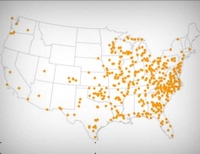Fixing prison-based gerrymandering after the 2010 Census: South Dakota
50 State Guide, March 2010
- Sections
- Impact at the state level
- Impact at the local level
- South Dakota law says a prison cell is not a residence
- Solutions
- Additional resources
Prison-based gerrymandering violates the constitutional principle of "One Person, One Vote." The Supreme Court requires districts to be based on equal population in order to give each resident the same access to government. But a longstanding flaw in the Census counts incarcerated people as residents of the prison location, even though they can’t vote and aren’t a part of the surrounding community.
When legislators claim people incarcerated in their districts are legitimate constituents, they award people who live close to the prison more of a say in government than everybody else.
Impact at the state level:
- Pennington County, which includes Rapid City, contains 12% of South Dakota’s population, yet 24% of the state’s prisoners come from the county. The political effect of this disproportionate incarceration rate is magnified by the fact that no state prisoners are incarcerated in Pennington County.
- Each Legislative district in South Dakota drawn after the 2000 Census should have had 21,567 residents. District 19, however, had only 19,850 actual residents. This gave every 92 residents of District 19 as much say over state affairs as 100 people elsewhere in the state.
- Crediting all of South Dakota’s incarcerated people to a few locations enhances the political clout of the people who live near prisons, while diluting voting power of all other South Dakotans.
Impact at the local level:
- Bon Homme County's District 5 contains Mike Durfee State Prison, which would distort voting power in county government, but the county rejected the Census Bureau's prison miscount when drawing districts after the 2000 Census, and instead based it's districts on actual resident populations.
South Dakota law says a prison cell is not a residence:
- Incarceration is not voluntary, so a prison cell cannot be a residence under South Dakota law, which defines residence as, “The place in which a person has fixed his or her habitation and to which the person, whenever absent, intends to return.… A person is considered to have gained a residence in any county or municipality of this state in which the person actually lives, if the person has no present intention of leaving.” (South Dakota Codified Laws, §12-1-4.)
Solutions:
- Ideally, the U.S. Census Bureau would change where it counts incarcerated people. They should be counted as residents of their home — not prison — addresses. There is no time for that in 2010, but South Dakota should ask the Census Bureau for this change for 2020.
- After the 2010 Census, the state and its local governments should, to the degree possible, count incarcerated people as residents of their home communities for redistricting purposes. Where that is not feasible, incarcerated people should be treated as providing unknown addresses instead of being used to pad the legislative districts that contain prisons.
Additional resources:
- District-by-district analysis of prison-based gerrymandering in South Dakota state legislative districts. Prisoners in the census dilute democracy in South Dakota by Peter Wagner, November 15, 2004.
Events
- April 15-17, 2025:
Sarah Staudt, our Director of Policy and Advocacy, will be attending the MacArthur Safety and Justice Challenge Network Meeting from April 15-17 in Chicago. Drop her a line if you’d like to meet up!
Not near you?
Invite us to your city, college or organization.



